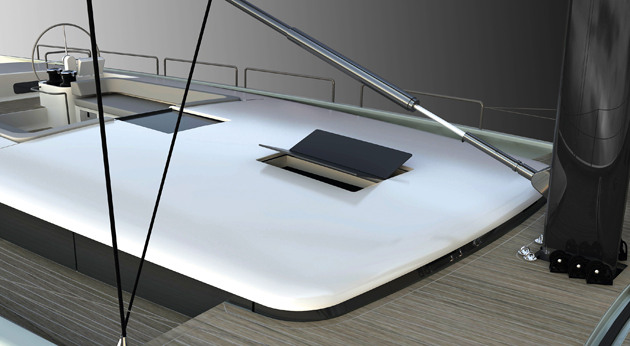The vision behind the design of this arresting new sloop, the owner of the yard and the first boat to be built is former Hanse Yachts owner Michael Schmid
Big names may draw the crowds to the red carpets, but they don’t always guarantee success. The fact that Italian style icon Brenta Design is behind this new carbon cruiser, plus a certain world-renowned architect – Sir David Chipperfield’s first foray into boat design – will certainly help cultivate interest in this arresting new sloop.
Lorenzo Argento, designer and now director of Brenta Design, has produced a very clever concept for this 80-footer: a triple-level deck that creates a sunken centre cockpit. And while there are only a few images to go on so far, Chipperfield’s interior looks understated, yet practical and sympathetic to the exterior lines.
However, it is the third name behind this new Brenta 80DC that will perhaps be the most intriguing. The vision behind the design, the owner of the yard and the first boat to be built is former Hanse Yachts owner Michael Schmidt. After four decades in the yacht production business, Schmidt sold Hanse Yachts in 2011 and went cruising for two years aboard his Hanse 630.
Wanting to upsize, he could not find a yacht to match his wishes, which included modern looks with classic features, a yacht with simple systems that is easy to sail fast and to maintain. So he formed a new luxury custom yacht building company, Michael Schmidt Yachtbau, based in his hometown of Greifswald where Hanse also remains.
High-end luxury
“There is so much infrastructure here and we know all the suppliers,” says the typically laid-back Schmidt. He stresses that the difference between his new venture and his production boatbuilding days is that he wants to do only a small number of high-end luxury products and to keep them simple.
The first will be this contemporary 80-footer, no 1 of which is being built for Schmidt himself and will launch in the early summer. It is a fast cruiser designed for bluewater, yet will be fun to sail with minimal crew. Designer Argento explained how the requirement for an extra-large master cabin led him to produce this novel take on the age-old centre-cockpit design.
Argento sketched a simple three-deck concept when they met up at Monaco Yacht Show in 2013. “Michael wanted 600mm bulwarks, so we worked at the idea of having a flush foredeck while keeping bulwarks aft,” Argento explained, pointing out that Brenta and Wally have used bulwarks to great effect for 25 years. The result is that the deck tiers up from a protected aft terrace to a foredeck with just 100mm of bulwark.
This creates innovative aesthetics with a coachroof that sinks into the deck aft, so the superstructure appears ultra low-profile, barely noticeable from water level. “The low-profile deckhouse rests behind the bulwark like a cottage behind a hedgerow,” is how Argento quaintly puts it.
Chipperfield interior
Argento’s concept was enough to attract one of his notable past clients to the project. Sir David Chipperfield is a keen sailor and Brenta 42 owner, who appreciated the potential. “I adapted the interior to a comfortable interpretation of the exterior that interacts with the architecture of the yacht,” he said. The furniture features rounded corners and padded surfaces that are practical at sea. He deliberately left the framework exposed, “avoiding domestic stereotypes,” he explained.
Future clients will be able to specify a custom interior or the Chipperfield design. The furniture is being built in carbon sandwich. Carbon was specified throughout because Schmidt wanted to keep weight down. “It’s nice to have a boat that can accelerate fast and do 13-15 knot speeds – cruising is easier, deck fittings are all lighter.” Performance is key to Schmidt, an ex-Admiral’s Cup sailor and still a talented Dragon competitor.
Hulls are produced at Rega in Poland, a yard with a name for specialising in composite hull production – clients include Vismara, Comet and Mylius (see page 68). They are then fitted out at Schmidt’s new facility in Greifswald. When pushed on pricing, Schmidt says the Brenta 80 will work out significantly less than a Swan and only a little more than a CNB 76 when taking into account full specifications. Potentially around the €4m (£3.1m) mark then.
Three versions of the Brenta 80 are offered: a centre-cockpit like this first model, an aft cockpit or a deck saloon. Also in design is a 100ft version and a day powerboat of around 42ft.
Is Michael Schmidt moving into Wally territory? “For us this is a hobby,” says Schmidt. “We are doing it because we love boats and the nicest thing is to create boats and see how they work out . . . and it’s a nice way to finish off my career, to do a luxurious product that I can put passion and heart into.”
Price circa £3m. www.msyachtbau.com
Dimensions
LOA 23.99m/78ft 9in
LWL 21.75m/71ft 4in
Beam 6.00m/19ft 8in
Draught fixed keel 3.50m/11ft 6in
Displacement 30,900kg/68,122lb
This is an extract from a feature in Yachting World March 2015








